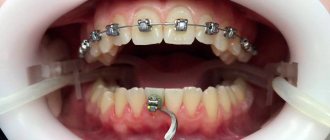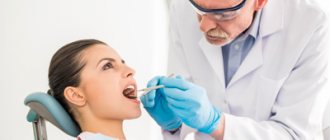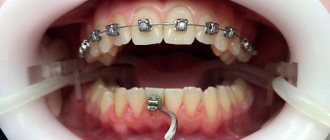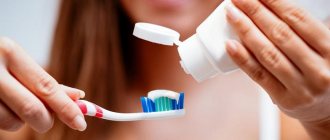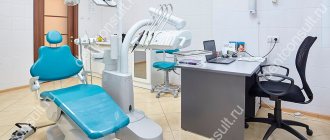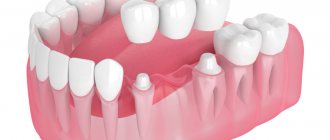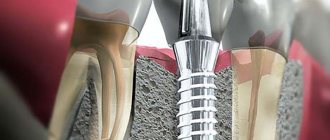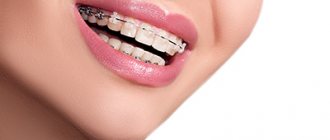Hi all! My name is Sakadynets Alexander, I have been practicing for 12 years and the number of my patients has exceeded 1000. Very often I hear repeated questions from my patients, and I understand how little quality information there is on the Internet and other sources. Sometimes the questions are logical, sometimes they are formed from incorrect information taken from various sources. Alas, myths and prejudices regarding braces still exist in society: supposedly braces contribute to the development of oral diseases, treatment with braces is painful, braces are created only for people under 18 years of age, etc. So, it’s time to collect all these questions in a bunch and try to give explanatory answers to them. I would like to note right away that not a single article can replace a live consultation with a doctor; it is for general informational purposes only.
I want braces on one jaw!
Quite a tempting option for many. But it should be understood that the answer lies already in the name “bracket-SYSTEM”, which implies the SYSTEMIC work of the orthodontic apparatus. And initially, such a decision may be completely wrong, and the amount saved will no longer be so, because all the treatment, and most importantly - time, will go down the drain.
Why?
It's all about the relationship between the upper and lower jaws: when one row of teeth moves, the other follows. And the conclusion from this is the following: braces are not installed with the aim of “straightening” some teeth. The braces system helps to change the position of the dentition in order to improve the bite! Simply put, a proper bite is when one jaw fits over the other like the gears in a watch.
What happens while wearing braces on one jaw? While the system has moved the tooth in the desired direction, another row of teeth tries to move it back. However, in some cases, the option of installing braces on one jaw is acceptable. For example, if the bite is already correct, but there is symmetry of the jaws. Or when connecting another jaw is necessary based on the patient’s clinical case.
Photo while wearing braces
Photo after wearing braces
Excessive eruption of lateral teeth in the absence of antagonists in the opposite row
If one or two upper molars for any reason lack antagonists in the lower jaw, they will erupt until they reach contact. Therefore, before starting prosthetics in the lower row, it is necessary to return the excessively protruded upper teeth to the correct position in order to obtain a place that is currently missing for prosthetics.
In such situations, not only braces are used, but also microimplants, which in this case serve as temporary additional support. The treatment is carried out only on the upper jaw and requires high skill. You can insert a tooth no more than 2–3 mm, and for this you will need to accurately calculate the magnitudes and directions of all forces acting on it.
Will braces ruin my teeth?
Let me say right away that braces do not damage your teeth. But only subject to hygiene rules and doctor’s recommendations. But here it is better to dispel several myths at once:
No. 1 Teeth under braces will definitely deteriorate
Nothing exactly happens under the braces, but the whole problem usually occurs around the braces - if the patient does not brush his teeth after every meal, then caries forms as a result.
Or if the patient has a strong tendency to form plaque (in this case, hygiene should be more careful). But if the patient could not agree on hygiene during treatment, then I usually suggest, and sometimes insist, that the orthodontic treatment be completed.
No. 2: The enamel may come off along with the braces.
When removing the braces, the doctor leaves some of the glue on the tooth, which is then easily removed with a bur, and then the teeth are polished. In this case, the enamel remains intact and unharmed.
#3: Teeth may fall out after braces.
Basically, patients understand that after proper treatment this is in no way possible. Mobility of teeth during treatment with braces - this happens, and this is normal (after all, teeth move, and this is quite logical). Retention, consisting of both removable and non-removable devices (retainers, mouth guards, plates), will help maintain the position of teeth after treatment, which will help keep the teeth in their correct position.
Material of manufacture
In terms of material, there are braces made of metal, ceramic, plastic and combined models. The peculiarities of the manufacturing material, the complexity of the clinical case, aesthetic requirements and financial capabilities allow the doctor and the patient to jointly decide which bracket system is better. There are no universal recommendations.
Ligature systems are made from a metal alloy (Orthos, Mini Diamond) and transparent artificially grown sapphire (aesthetic Inspire ICE). Aesthetic ligature braces are superior in size to metal structures. The disadvantage is more complex activation and an increased period of patient adaptation to foreign structures.
aesthetic sapphire Inspire ICE
Non-ligature structures are made of metal (Damon Q, Damon 3MX) and especially durable ceramics (Damon Clear 2). The adaptation period is easier than when installing devices with ligatures. Treatment with Damon systems is reduced by an average of 7 months compared to treatment with ligature braces.
teens with Damon Q braces
If psychological comfort or the characteristics of an adult patient’s profession require an inconspicuous system, it is advisable to choose Inspire ICE sapphire braces or Damon Clear 2 ceramic braces. For a child, sapphire and ceramic structures are not always a good choice due to increased fragility: a teenager can accidentally damage the elements of the system as a result injury or poor diet.
transparent Inspire ICE on typodont
What is a good orthodontist?
Personally, I am always in favor of the patient receiving at least two third-party opinions. Orthodontic treatment must be approached very seriously, because you are committed to a relationship with the doctor for 1-2 years (or even more). Without mutual understanding, orthodontic treatment is doomed! There are several most important criteria when choosing a doctor:
- High-quality collection of information/diagnostic data
The doctor must make impressions, then carry out calculations on the models, study the OPTG image or CBCT (3-D image), and take intraoral photographs. ONLY after this can you begin treatment with the bracket system. Taking photographs is also a very important diagnostic step.
- Reviews and reputation
I won’t say obvious things here, but it’s worth paying more attention to the doctor’s actual work, rather than reviews on his personal page. By the way, negative reviews are often really unsolicited, but they can be found for literally every doctor (even the best of the best), so filter the information received. Well, no one canceled the recommendations of friends.
- Availability of diplomas/certificates
Having certificates is far from an empty phrase. This suggests that the doctor wants to develop in his field and know about new developments in the field of medicine. Do not hesitate to ask questions about where the doctor received his knowledge, practice, etc.
- Employment
Sometimes we have to work quickly, on the fly. But alas, the case is not always immediately clear. And in general, orthodontics is a science where you need to think a lot. After all, bite alignment is a kind of arcade game for the doctor. Just clarify what the doctor's plans are for you and make sure that the doctor treats your case carefully.
Orthodontists KANO
Which bracket system is better: self-ligating and ligature designs
Bite correction systems differ in the method of fixing the archwire in the bracket groove. The classic option is ligature constructions. The arch is tightly fixed to each bracket with elastic or metal ligatures. The design is suitable for the treatment of anomalies of varying complexity. It is necessary to visit a doctor once a month to replace the archwires.
Orthos ligature braces
Self-ligating structures do not have elastic and wire elements fixing the arch in the bracket groove. Friction in the system is minimal. Arc sliding occurs under the influence of weak forces. Non-ligation structures do not require monthly visits to the doctor: it is enough to carry out activation once every 2-3 months.
self-ligating Damon Q2
According to the results of research by Khalid S. Hassan from the University of Ed-Dammam, Saudi Arabia, it was revealed that the microbial flora in the oral cavity when using self-ligating systems was lower than when treated with ligature structures. 22 patients participated in the study. In each case, two ligation systems were fixed in the oral cavity: ligature structures were installed on one side, and devices without ligatures were installed on the other. The use of ligature systems caused microbial colonization and increased the activity of the enzyme aspartate aminotransferase. Treatment with self-ligating braces turned out to be a more preferable method of occlusion correction from the point of view of preventing disorders in periodontal tissues.
What are the best braces for a child? Each clinical case requires an individual approach from the orthodontist. Only a doctor, based on the diagnosis and structural features of the young patient’s dental system, offers the most suitable options. As a rule, the issue of aesthetic preferences in children is not as acute as in adults. Teenagers often choose ligature or non-ligature metal systems. A wide variety of elastic ligatures allows you to express the individuality or mood of the child, and the visibility of the design has ceased to be a criterion for choosing a system. Teenagers wear devices with multi-colored elastic elements and do not experience discomfort.
non-ligature Damon 3MX metal
When treating children with braces, it is important for parents to pay attention to teaching the child oral hygiene and motivate them to follow all the orthodontist’s recommendations. Some teenagers, despite the instructions of their parents, pay insufficient attention to hygiene procedures. In this case, installing a non-ligature brace system for a child will be a more preferable option.
I'm already old/too old for braces
In fact, today the framework in orthodontic treatment has been completely erased. Of course, each age has its own subtleties of work for a doctor. However, the result is always the same. And one more fact - people sometimes lose their teeth not because of caries and other dental problems, but because of an incorrect bite. When the load is distributed unevenly, it ultimately leads to bone loss and tooth wear.
I will not tire of repeating that we do straight teeth not only to solve aesthetic problems. Often this will save you from early tooth loss.
In what cases are internal braces not used?
For a number of clinical cases, invisible braces are the best treatment option. For example, lingual braces for deep bites work much more effectively than vestibular braces. However, there are a number of restrictions under which it is better not to place lingual braces on teeth. Among them:
- periodontal diseases;
- low dental crown;
- dysfunction of the temporomandibular joint;
- allergy to the materials from which the system is made;
- bruxism;
- too narrow jaw;
- severe crowding of teeth;
- age under 11 years.
After getting braces, will I have to go on a strict diet?
Undoubtedly, there will be changes in diet, but they are absolutely not worth the fears associated with the myth that braces deprive you of gastronomic joys. You will just need to be more careful and exclude only some of the products (nuts, puffed rice, popcorn, caramel, nougat, seeds, chewing gum, etc.).
First of all, this is necessary in order not to clog the spaces between the grooves of the braces, where bacteria can accumulate and caries can develop. You should also avoid drinks with dyes, hot and cold drinks (temperature changes can cause the braces to come off).
Think for yourself, after all, braces are even a kind of motivation to start a healthy lifestyle, because it is mainly harmful foods that are excluded.
Eating while wearing braces
Differences between structures for the upper jaw and purpose
Using the device only for the upper jaw is recommended to eliminate problems with one or two teeth and in case wearing a mouth guard does not bring results. Externally, this is a classic type of system that can be installed outside or inside the row. Purpose:
- correction of minor malocclusions;
- the number of uneven teeth is small;
- no oral diseases.
For the maxilla, labial braces are commonly used. For those Patients for whom aesthetics are important, transparent braces are recommended. They are hardly noticeable when worn and do not cause discomfort. Materials such as artificial sapphire, ceramics or plastic are used for manufacturing.
Is it possible to wear braces during pregnancy?
Modern braces are absolutely harmless to the body and do not cause allergies. Therefore, wearing them in itself does not in any way affect the course of pregnancy and the intrauterine development of the child. But this is subject to careful oral care! ⠀ Of course, hormonal imbalance affects the condition of the bone, but here it is necessary to conduct research from specialists and only after that decide whether treatment or continuation of treatment during pregnancy is possible. It is better to plan the installation of braces 1-2 months before pregnancy, so that all the necessary studies do not negatively affect the fetus (X-rays, CT scans, etc.). ⠀ According to experienced orthodontists, if a woman becomes pregnant, then there is no need to do anything special. It makes sense to wear braces until you finish breastfeeding, even if it is possible and will be for quite a long time. However, this will allow the bone tissue to normalize, and the woman will not miss out on the results of treatment already obtained before pregnancy. If you are pregnant or plan to become pregnant, be sure to talk to your doctor. Only a specialist will be able to correctly assess your condition and prescribe the necessary course of action!
Is it possible to treat teeth during pregnancy?
How to choose the best braces?
Which braces are best for an adult, and which ones are more suitable for teenagers or young patients? All these nuances should be worked out together with a specialist, taking into account diagnostic calculations, the clinical situation itself, the individual characteristics of the body, concomitant diseases, financial capabilities, etc. It will take more than one year to walk with such a design, so it is worth thinking through all aspects of the course of treatment in advance.
At Implantmaster, our specialists will help you determine which bracket system best suits you and your clinical situation. Orthodontists have the skills to fix various systems, and services are provided at a reasonable price. Sign up using the phone number on the website, or leave a request for feedback.
Author:
Is it possible to do without retention and what is it even?
Retention is perhaps one of the most important parts of the entire treatment. Why? Teeth are harmful guys, and they will try to return to their original position, which is comfortable only for them. This is called a relapse. But neither I nor my patient want this. That’s why I really insist on retention, often even suggesting double retention.
What is retention? This is a removable or non-removable device designed to hold the dentition in the desired position. This could be a splint, a retainer (an arch behind the teeth), a night guard, or a plate.
Retainer after braces

